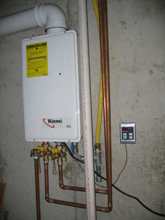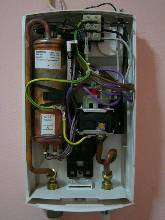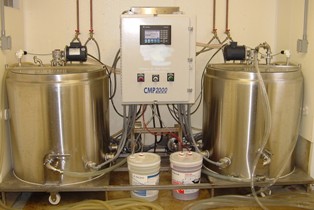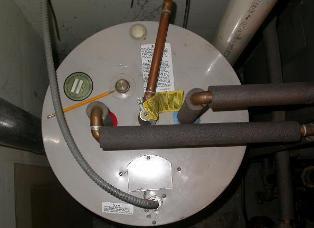Electrode heating of liquid media
Method for heating an electrode used for heating wires II mil: water, milk, fruit and berry juices, soil, concrete, etc. Electrode heating is widespread in electrode boilers, boilers for hot water and steam, as well as in the processes of pasteurization and sterilization of liquid and wet media, heat treatment of feed.
The material is placed between the electrodes and heated by an electric current passing through the material from one electrode to the other. Electrode heating is considered direct heating—here, the material serves as a medium in which electrical energy is converted to heat.
Electrode heating is the simplest and most economical way to heat materials; it does not require special power supplies or heaters made of expensive alloys.
The electrodes supply current to the medium to be heated, and they themselves are practically not heated by the current. Electrodes are made of non-deficient materials, most often metals, but they can also be non-metallic (graphite, carbon). To avoid electrolysis, use only alternating current.
The conductivity of wet materials is determined by the water content, therefore, in the following, electrode heating will be considered mainly for heating water, but the given dependencies are also applicable for heating other wet media.
Heating in an electrolyte
In mechanical engineering and repair production, they use heating in an electrolyte... The metal product (part) is placed in an electrolyte bath (5-10% solution Na2CO3 and others) and connected to the negative pole of the direct current source. As a result of electrolysis, hydrogen is released at the cathode and oxygen at the anode. The layer of hydrogen bubbles covering the part represents a high current resistance. Most of the heat is released into it, heating the part. At the anode, which has a much larger surface area, the current density is low. Under certain conditions, the part is heated by electrical discharges that occur in the hydrogen layer. The gas layer at the same time serves as thermal insulation, preventing the part's electrolyte from cooling.
The advantage of heating in the electrolyte is a significant energy density (up to 1 kW / cm2), which provides a high heating rate. However, this is achieved through increased power consumption.
Electrical resistance of wires II mil
Conductors II type called electrolytes... They include aqueous solutions of acids, bases, salts, as well as various liquid and moisture-containing materials (milk, wet feed, soil).
Distilled water is available electrical resistance about 104 ohm x m and practically does not conduct electricity, and chemically pure water is a good dielectric. "Ordinary" water contains dissolved salts and other chemical compounds whose molecules dissociate in water into ions, giving ionic (electrolyte) conductivity.The specific electrical resistance of water depends on the concentration of salts and can be approximately determined by the empirical formula
p20 = 8 x 10 / C,
where p20 — specific resistance of water at 200 C, Ohm x m, C — total concentration of salts, mg / g
Atmospheric water contains no more than 50 mg/l of dissolved salts, river water — 500 — 600 mg/l, groundwater — from 100 mg/l to several grams per liter. The most common values for effective electrical resistance p20 for water are in the range 10 — 30 Ohm x m.
Electrical resistance of type II conductors depends significantly on temperature. As it increases, the degree of dissociation of salt molecules into ions and their mobility increases, as a result of which the conductivity increases and the resistance decreases. For any temperature T before the start of noticeable evaporation, the specific electrical conductivity of water, Ohm x m -1, is determined by the linear dependence
yt = y20 [1 + a (t-20)],
where y20 — specific conductivity of water at a temperature of 20 o C, a — temperature coefficient of conductivity equal to 0.025 — 0.035 o° C-1.
In engineering calculations, they usually use resistance rather than conductivity.
pt = 1/yt = p20 / [1 + a (t-20)] (1)
and its simplified dependence p (t), taking a = 0.025 o° C-1.
Then the water resistance is determined by the formula
pt = 40 p20 / (t +20)
In the temperature range 20 — 100 OS, the water resistance increases 3 — 5 times, the same time changes the power consumed by the network.This is one of the significant disadvantages of electrode heating, which leads to an overestimation of the cross-section of the supply wires and complicates the calculation of electrode heating installations.
The specific resistance of water obeys dependence (1) only before the start of noticeable evaporation, the intensity of which depends on the pressure and current density in the electrodes. Steam is not a conductor of current and therefore the resistance of water increases during evaporation. In the calculations, this is taken into account by the coefficient bv depending on the pressure and current density:
desktop pcm = strv b = pv a e k J
where desktop m — specific resistance of the mixture water — steam, strc — specific resistance of water without noticeable evaporation, a — a constant equal to 0.925 for water, k — value depending on the pressure in the boiler (you can take k = 1.5 ), J — current density on the electrodes, A / cm2.
At normal pressure, the evaporation effect is effective at temperatures above 75 °C. For steam boilers, the coefficient b reaches a value of 1.5.
Electrode systems and their parameters
Electrode system — a set of electrodes, connected in a certain way to each other and to the power supply network, designed to supply current to the heated environment.
The parameters of electrode systems are: number of phases, shape, size, number and material of electrodes, distance between them, electrical circuit connections («star», «delta», mixed connection, etc.).
When calculating electrode systems, their geometric parameters are determined, which ensure the release of a given power in the heated environment and exclude the possibility of abnormal modes.
Supplying a three-phase electrode system in a star connection:
P = U2l / Rf = 3Uf / Re
Supplying a three-phase electrode system with a delta connection:
P = 3U2l / Re
 At a given voltage Ul power electrode system P is determined by the phase resistance Rf, which is the resistance of the heating body closed between the electrodes that form the phase. The shape and size of the body depends on the shape, size and distance between the electrodes. For the simplest electrode system with flat electrodes each b, height h and the distance between them:
At a given voltage Ul power electrode system P is determined by the phase resistance Rf, which is the resistance of the heating body closed between the electrodes that form the phase. The shape and size of the body depends on the shape, size and distance between the electrodes. For the simplest electrode system with flat electrodes each b, height h and the distance between them:
Rf = pl / S = pl / (bh)
where, l, b, h — geometric parameters of the plane-parallel system.
For complex systems, the dependence of Re on geometrical parameters does not seem so easy to express. In the general case, it can be represented as Rf = s x ρ, where c is a coefficient determined by the geometrical parameters of the electrode system (can be determined from reference books).
Dimensions of the electrodes to ensure the required value Rf, can be calculated if the analytical description of the electric field between the electrodes is known, as well as the dependence p on the factors that determine it (temperature, pressure, etc.).
The geometric coefficient of the electrode system is found as k = Re h / ρ
The power of any three-phase electrode system can be represented as P = 3U2h / (ρ k)
In addition, it is important to ensure the reliability of the electrode system, to exclude product damage and electrical breakdown between the electrodes. These conditions are met by limiting the field strength in the interelectrode space, the current density on the electrodes and the correct choice of the electrode material.
The permissible strength of the electric field in the interelectrode space is limited by the requirement to prevent electrical breakdown between the electrodes and disrupt the operation of the installations. Permissible stress Eadd the fields are selected according to the dielectric strength Epr the fields are selected according to the dielectric strength Epr of the material, taking into account the safety factor: Edop = Epr / (1.5 … 2)
The Edon value determines the distance between the electrodes:
l = U / Edop = U / (Jadd ρT),
where Jadd — permissible current density on the electrodes, ρt is the resistance of water at operating temperature.
 According to the experience of the design and operation of electrode water heaters, the value of Edon is taken in the range (125 ... 250) x 102 W / m, the minimum value corresponds to the resistance of water at a temperature of 20 О. At less than 20 Ohm x m, the maximum is the resistance of water at a temperature of 20 OC more than 100 Ohm x m.
According to the experience of the design and operation of electrode water heaters, the value of Edon is taken in the range (125 ... 250) x 102 W / m, the minimum value corresponds to the resistance of water at a temperature of 20 О. At less than 20 Ohm x m, the maximum is the resistance of water at a temperature of 20 OC more than 100 Ohm x m.
The permissible current density is limited due to the possibility of contamination of the heated environment with harmful products of electrolysis at the electrodes and decomposition of water into hydrogen and oxygen, which form an explosive gas in the mixture.
The permissible current density is determined by the formula:
Jadd = Edop / ρT,
where ρt is the water resistance at the final temperature.
Maximum current density:
Jmax = kn AzT / C,
where, kn = 1.1 ... 1.4 — a coefficient taking into account the unevenness of the current density on the surface of the electrode, Azt is the strength of the working current flowing from the electrode at the final temperature, C is the area of the active surface of the electrode.
In all cases, the following condition must be met:
ДжаNS add
Electrode materials must be electrochemically neutral (inert) with respect to the heated environment. It is unacceptable to make electrodes from aluminum or galvanized steel. The best materials for electrodes are titanium, stainless steel, electric graphite, graphitized steels. When heating water for technological needs, ordinary (black) carbon steel is used. Such water is not suitable for drinking.
Adjusting the power of the electrode system possible by changing the U and R values... Most often, when adjusting the power of the electrode systems, they resort to changing the working height of the electrodes (the area of the active surface of the electrodes) by introducing dielectric screens between the electrodes or changing of the geometric coefficient of the electrode system (determined by reference books depending on the diagrams of the electrode systems).


